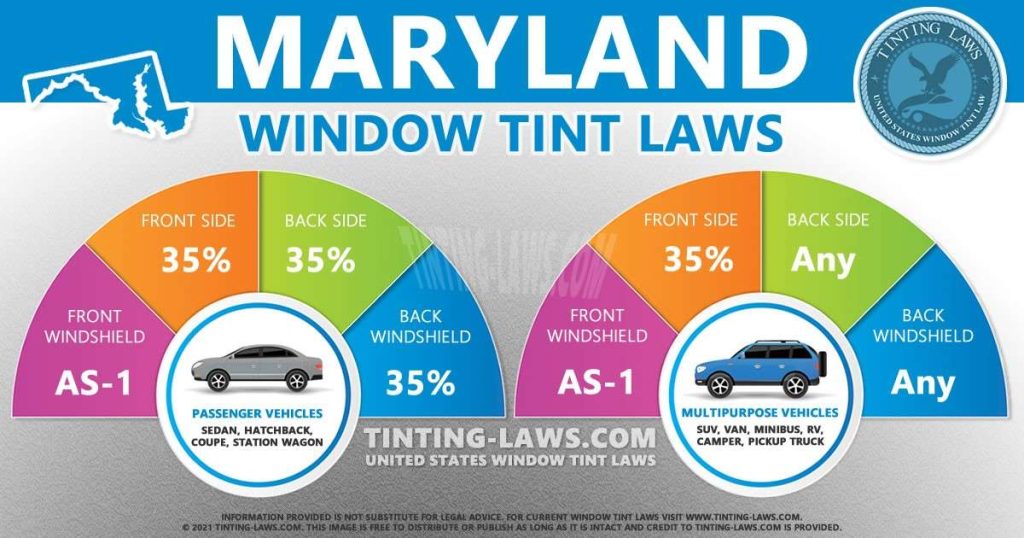Maryland Window Tinting Laws
Car window tinting laws in Maryland were enacted in 1995.
We have provided all the necessary information about your car’s window tint, including how dark or reflective the tint is allowed in your state.
There are also additional car window tinting rules and regulations in Maryland so make sure you read all about it below.
Window tint darkness in Maryland
The percent of visible light allowed through your car windows is called VLT: Visible Light Transmission.
The percentage of light allowed through your film and glass in Maryland is very specific and different for sedan cars and SUV cars or vans.
Tint darkness for sedans:
- Windshield: Non-reflective 35% VLT tint is allowed on the AS-1 line or top 5 inches of the windshield.
- Front Side windows: Must allow more than 35% of light in.
- Back Side windows: Must allow more than 35% of light in.
- Rear Window: Must allow more than 35% of light in.
Tint darkness for SUV and vans:
- Windshield: Non-reflective 35% VLT tint is allowed on the AS-1 line or top 5 inches of the windshield.
- Front Side windows: Must allow more than 35% of light in.
- Back Side windows: Any darkness can be used.
- Rear Window: Any darkness can be used.
Break light in back window must not be covered with tint.
Window tint reflection in Maryland
Window tint can reflect incoming light and reduce glare and heat.
Maryland window tint law permits a certain window reflection when using a tint so make sure you pay attention to this as well.
Tint reflection for sedans:
- Front Side windows: No metallic or mirrored appearance.
- Back Side windows: No metallic or mirrored appearance.
Tint reflection for SUV and vans:
- Front Side windows: No metallic or mirrored appearance.
- Back Side windows: No metallic or mirrored appearance.
Other Maryland window tint rules and regulations:
Maryland does have several other important laws, rules and regulations pertaining to window tinting. They include the following:
- Side Mirrors: If the back window is tinted dual side mirrors are required.
- Restricted Colors: Tint colors red, yellow and amber are not legal by Maryland law.
- Certificates: Manufacturers of film need to certify the film they sell in the state. Ask your dealer if they are using certified film.
- Stickers: Maryland law does not require a sticker to identify legal tinting, but it’s recommended to have one between the film & glass on each tinted window.
- Medical Exceptions: Maryland does allow medical exemptions for special tint. For more details about the specific terms of the exemption, consult your state law.
- Penalties: Traffic offense, plus SERO: Safety Equipment Repair Order requiring certification of tint in inspection station.
Keep in mind that Maryland tinting laws and regulations may be interpreted differently in your county or place of residence.
We always recommend double-checking our information with your local DMV or law enforcement authorities.

Our information about window tint laws in Maryland was last updated in 2024.
Tinting laws in Maryland were enacted in 1995.
In case any of our info provided is not up to date or correct be sure to contact us so we can fix it. Thanks!
Trusted industry leader in providing accurate window tint laws. Share with confidence:
State of Maryland Info
Maryland is a U.S. state located in the Mid-Atlantic region of the United States, bordering Virginia, West Virginia, and the District of Columbia to its south and west; Pennsylvania to its north; and Delaware to its east.
Maryland was the seventh state to ratify the United States Constitution, and has three occasionally used nicknames: the Old Line State, the Free State, and the Chesapeake Bay State.

Maryland is one of the smallest states in terms of area, but it remains one of the most populous as well as one of the most densely populated states of the United States.
The state’s largest city is Baltimore, and its capital is Annapolis.
Capital: Annapolis
Population: 5,884,563
Area: 12,407 sq mi (32,133 km2)
Cities in Maryland: Baltimore, Annapolis, Rockville, Ocean City, Gaithersburg, Frederick, Hagerstown, National Harbor, Laurel, College Park, Bowie, Salisbury, Hyattsville, Greenbelt, Cumberland, St. Michaels, Havre de Grace, Walden Farms, Bel Air, Upper Marlboro, Takoma Park, Easton, Westminster, Chevy Chase, Montgomery Village, Elkton, Kensington, Landover, Aberdeen, Chestertown, Frostburg, Cambridge, Millersville, Capitol Heights, La Plata, Lanham, Berlin, Oxon Hill, Hanover, Sherbert, Sykesville, Hunt Valley, Oxford, North Beach, Boonsboro, Emmitsburg, Mount Airy, Chesapeake Beach, Boyds, Burkittsville
Counties in Maryland: Allegany, Anne Arundel, Baltimore, Calvert, Caroline, Carroll, Cecil, Charles, Dorchester, Frederick, Garrett, Harford, Howard, Kent, Montgomery, Prince George’s, Queen Anne’s, Saint Mary’s, Somerset, Talbot, Washington, Wicomico, Worcester
Tint law references:
Maryland Transportation Code section 22-406: Safety glazing material in motor vehicles